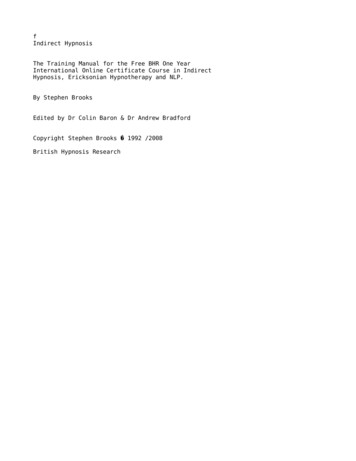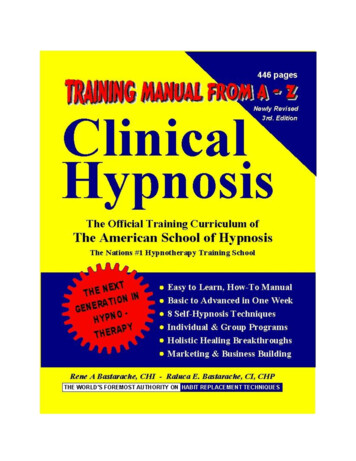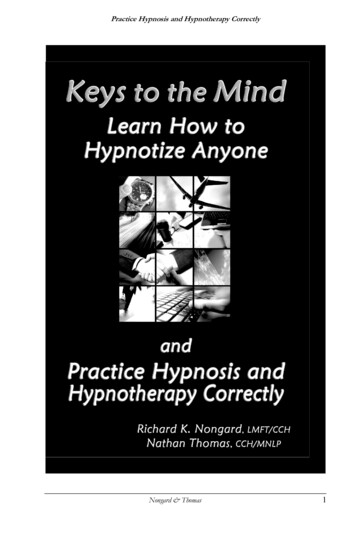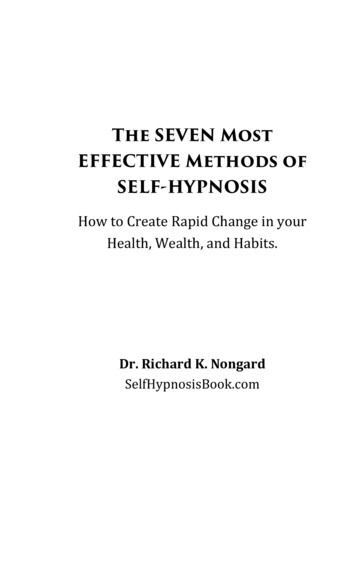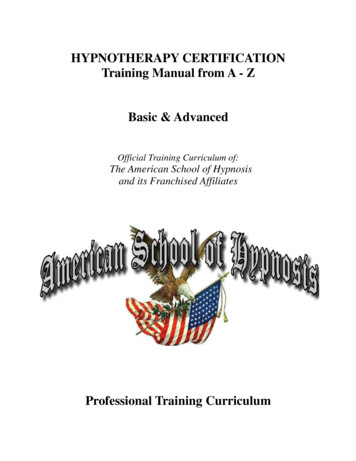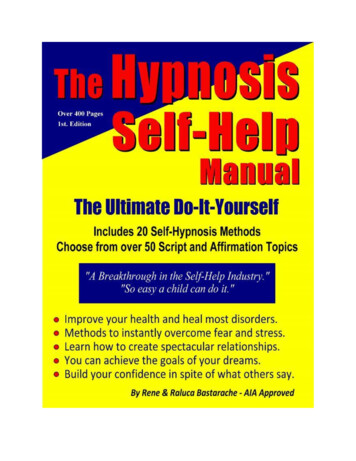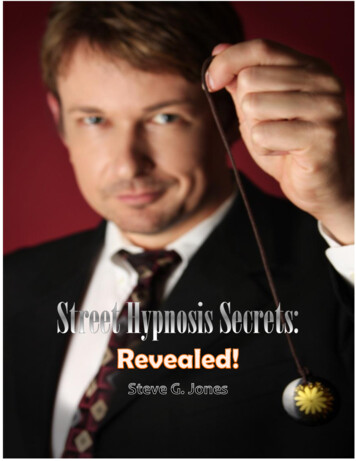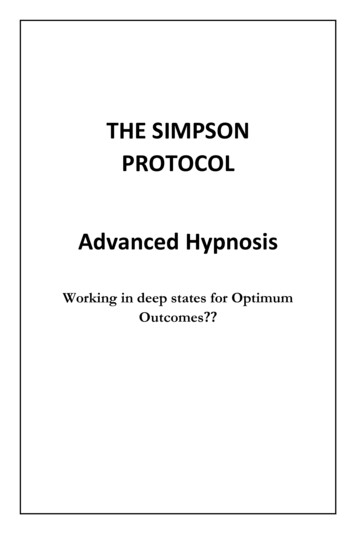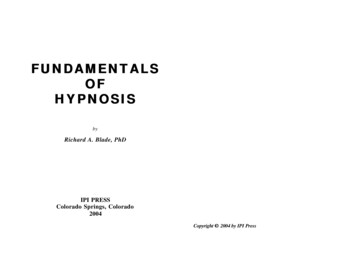
Transcription
FUNDAMENTALSOFHYPNOSISbyRichard A. Blade, PhDIPI PRESSColorado Springs, Colorado2004Copyright 2004 by IPI Press
PREFACEThis is the first in a series of three textbooks on hypnosisfollowing the organization of my three major workshops:INTRODUCTORY HYPNOSIS, SELF HYPNOSIS, andTHERA-PEUTIC HYPNOSIS. It is designed for personsinterested in learning hypnosis to begin by reading the book.The second recommended step is to take an introductoryworkshop.As in the case of my introductory hypnosis workshop, thebook deals with the possible applications of hypnosis, thenature of the hypnotic state, and how to induce hypnosis. As Ishall state on any number of occasions in the book, the key tousing hypnosis is not in the induction of the state, but rather themanner of giving suggestions while in the hypnotic state. Youcan learn how to hypnotize yourself and others in a mere six hour workshop, but it takes the rest of your life to develop theunderstanding and skill to effectively use the hypnosis. Theother two books are devoted to preparing the foundation fordeveloping those skills. The second book, SELF HYPNOSIS, asthe title implies, deals with the use hypnosis on yourself.Though there are exceptions, the best way of using hypnosis isthrough self hypnosis. The third book, THERAPEUTICHYPNOSIS, is designed for health and mental healthprofessionals, and teaches how to use hypnosis in thoseprofessions.As I shall point out in Section 4.2, this book does not takethe place of a hypnosis workshop. Rather, it is the intellectualcontent of the introductory hypnosis workshop. After readingthis book you may or may not be able to hypnotize yourself orothers. However, you will understand much more about thesubject of hypnosis. I recommend either reading this bookbefore or after taking a hypnosis workshop. It will clear upmany issues that you might be concerned about, and it willallow you to concentrate on the demonstrations in theworkshop.If you take a workshop (either mine or anyone else's)before reading this book, you will still find the material in thisbook elucidating, and it will reinforce the learning that tookplace during that workshop. I allow free repetition of any ofmy workshops because the repetition is strong reinforcementand allows the participant to greatly increase his1 depth. Eachtime you read the book or attend a workshop, you will find youhave gained significantly.I tried to write this book in a readable, informal style ratherthan as a scholarly work. Nevertheless, I have made everyattempt to make the presentation objective and scientific. Thatis, when the material is a matter of conjecture or opinion, I tryto present it that way. I also decided to primarily cite casestudies based on my personal experience in the practice ofhypnosis rather than quoting those of others. Obviously this isanecdotal rather than statistical evidence. Many behavioralscientists do not regard anecdotal evidence to be worth much,but in hypnosis it plays an important role of indicating what ispossible. Statistics, by contrast, tells us, in principle, howoften we can expect to see a given result, given the equivalentprocedure. In hypnosis statistics invariably underestimate thecapabilities because very subtle differences in the hypnotist'spresentation, which need to be geared to the individual, greatlyaffect the outcome of an experiment. Experiments conductedwith such things as audiotapes to scientifically controlexperiments show only what is possible with that medium, andthat is usually significantly less than is possible with aninteracting hypnotist.While the field of clinical psychology is not greatlyscientific because of the tremendous difficulty in performingmeaningful experiments under good scientific controls, the areaof hypnosis is at least as well researched as any other area ofclinical psychology. I am particularly concerned that many"new" psychotherapies and personal improvement1 After carefully considering our various options, I have chosen to use “he”, "him" and "his"whenever there is an ambiguity in gender. I sincerely hope this does not offend anyone.
methodologies are continually being sold to mental healthprofessionals and the public -- not because they don't work, butbecause they are, in essence, hypnosis. Thus researchersstudying these methodologies are "reinventing the wheel"rather than extending the forefront of knowledge. At the timeof this writing the latest of such hypnotic techniques being“marketed” under a new name is “EMDR” (eye movementtherapy). The techniques are extremely primitive and thecapabilities far less than the more advanced techniquesdeveloped decades ago by hypnosis professionals.I sincerely hope that this book will serve to educate manypeople about the tremendous value of hypnosis, and how safe itis to use. I strongly believe every person can find significantvalue in hypnosis, and I believe all parents ought to teach theirchildren to be able to use hypnosis when they grow intoadulthood. After all, when children are young, they should betreated as if they are in hypnosis -- because for all practicalpurposes they are!Finally, I want to acknowledge that an initial version of thisbook was co-authored with a professional hypnotist, LarryRice, whom I professionally certified many years ago. WhileLarry contributed little to the structure of the book, he had agreat many case studies based upon his many years of hispractice. Shortly after I retired as a university professor andmoved to Denver, he moved to an unknown location, and Ihave been unable to contact him despite significant efforts. Inorder to complete the project without his participation, Iremoved all of his contributions and finished the book on myown.CONTENTSChapt. 1: The Power of oductionUndesirable HabitsMemoryLearning and PerformancePsychological ProblemsPain and Other SymptomsCirculation and BleedingHormone ControlSubconsciously Triggered DisordersPhysical HealingLimitationsChapter Summary11381112161922252728Chapt. 2: Nature of the dels of the MindConscious vs Subconscious MindsDevelopment of ReasoningAltered States of ConsciousnessDefinition of HypnosisWhat Hypnosis Feels LikeIndir ect Suggestionand Subliminal Communication2.8 Chapter Summary293031353537373940
Chapt. 3: Myths and 113.123.133.143.153.163.173.18IntroductionSelf Destructive ActsPsychotic IndividualsEmba rrassing or Unsocial ActsSeductionRejection of Random SuggestionsBeing Hypnotized UnwittinglyAwareness in the Hypnotic StateRemembering After the HypnosisOverusing HypnosisBrainwashingPersonality of a Hypnotist"Trapped" in HypnosisHypnotic SusceptibilityImportance of DepthThe Role of ConvictionInfluence vs ControlAdverse Effects of HypnosisChapter SummaryChapt. 5: Possible t. 4: The Initial Hypnosis ntroductionThe Induction MethodValue of a Hypnosis WorkshopPreliminariesThe Initial InductionThe Yardstick ScaleSafety SuggestionsFuture Hypnotic InductionsComing Out of the HypnosisThe Second InductionThe Self InductionPost Hypnotic DiscussionChapter 55.6IntroductionLack of MotivationResistancePrematurely Coming Out of HypnosisRefusing to Come Out of HypnosisInability to VisualizeChapter Summary65656667676869Chapt. 6: Some Things to Do With the cing HypnosisKeeping a JournalProcedure for Giving Yourself SuggestionsWording SuggestionsSome Things to AvoidRecommended ReadingChapter uthor Biography7982
1CHAPT 1: THE POWER OF HYPNOSIS2OVEREATINGChapter 1:THE POWER OFHYPNOSIS1.0 IntroductionMost people have some vague impression that hypnosis issometimes useful in treating bad habits such as smoking and overeating.Most have also heard of the use of hypnosis in recovering forgotten detailsof a crime or a traumatic event. Some are aware of the use of hypnosis incontrolling pain during natural childbirth. Very few people, however, knowof the true power of hypnosis. I begin this book by telling a little about theapplications of hypnosis to a wide variety of things. In doing so, Iemphasize my own personal experience to make the information morecredible.1.1 Undesirable HabitsSMOKINGPerhaps the most common application of hypnosis is in thetreatment of the smoking habit. H ypnosis is useful in gettingpeople to stop smoking, and it is easy to get immediate results.However, success rates tend to be somewhat less than isgenerally touted (39% by one study) when looking at a longperiod of time -- six months or longer. The success rate wouldundoubtedly improve dramatically if hypnosis were used toextinguish the new trigger when there is a relapse.Overeating is another habit frequently treated by hypnosis,and, like smoking, there tends to be immediate but temporaryresults. Again, as in the case of smoking, the long-termsuccess rate would dramatically improve if hypnosis were reapplied each time the habit returns.In controlled experiments subjects are usually given simplesuggestions that, for example, they will feel full and wonderfulafter eating only a small amount. Unfortunately, simplesuggestions often do not work in achieving weight loss.Sometimes the root of the problem lies with an event in thepast and there is no current need for it. To illustrate, I had ahypnosis student at the University1 who had previously triedall kinds of radical methods to control his weight. Though Ialways recommend against using self hypnosis for ageregression to discover traumatic memories, he age regressedhimself anyway, using appropriate safety suggestions, todiscover that as a young child he was not allowed to take hisfavorite teddy bear with him on a trip to Europe. Having gainedthe knowledge of this psychologically blocked traumaticmemory, he quickly lost significant weight and did not gain itback later.It is also common that overweight people have apsychological need for that weight, and that need must beaddressed before lasting weight loss can occur. Thepsychological need often stems from either not beingcomfortable with their bodies or not being comfortable withrelationships. It might even originate from fear of sexualadvances, and in some cases that fear might even relate tosexual abuse, incest, or sexual relations performed under duressa t an early age. In such cases the extra weight can act as aprotection barrier. Once the true cause of the need forprotection is found, it can be remedied and the weight can bepermanently shed.1 I am an emeritus physics professor at the University of Colorado - ColoradoSprings. In addition to physics, I taught introductory and advanced courses inhypnosis for a number of years.
3BLADE: FUNDAMENTALS OF HYPNOSISTRICK KNEEHypnosis is much more successful when applied to habitsthat have no psychological basis. A workshop participant inSan Diego came to me with a "trick knee". About once amonth she would dislocate her knee as she walked, ran, orturned in place, falling to the ground in severe pain. She thenhad to use crutches for about a week to recover.I hypnotized her and suggested that her subconscious mindtake the responsibility of preventing her from moving in such away as to throw out the knee. The next two days she phonedand complained of having pr oblems walking, but by the thirdday the subconscious mind had figured out how to control hermovements to prevent the problem. After that she quicklyrecovered her ability to walk and run, and at least for the nextcouple of years (the time I maintained contact with her) thetrick knee problem never recurred.1.2 MemoryWhile hypnosis can certainly be used to recover memorizedfacts for a school exam or the like, in this section I shall focusmy discussion on the recovery of lost memories.CRIMINAL INVESTIGATIONLaw enforcement agencies frequently use hypnosis to recallaccurate descriptions of perpetrators and other usefulinformation. One famous case broken through hypnosis wasthe Chowchilla kidnapping in California (1976). 26 childrenand a bus school bus driver were kidnapped and the entire buswas buried underground. The bus driver managed to escapeand contact authorities who then rescued the children. Throughhypnosis, the driver recalled all but one of the characters on thelicense plate number of the kidnappers' vehicle, leading toarrests.CHAPT 1: THE POWER OF HYPNOSIS4While hypnosis can be extremely valuable in theinvestigation of crimes, it is my opinion and that of manyothers that it is not an entirely reliable tool in courtroomtestimony due to the potential of an inadequately trainedhypnotist to lead a witness into false memories while underhypnosis. Historically, Sigmund Freud gave up hypnosis afterhe became convinced that many young women werefantasizing childhood sexual molestation under hypnosis. Inmore recent times therapists have become aware of the fact thatchildhood molestation is much more common than originallythought, but it can, in fact, be fantasizing.In the case of children, the problem is particularly acute.(As I shall discuss in my book on therapeutic hypnosis,children behave essentially as if they are always in a state ofhypnosis.) In research done after a number of daycare centerpersonnel were wrongly imprisoned for sexual abuse,researchers merely asked children at regular intervals, withoutany prompting, even subtlely, about events at a particular timewhen it had already been established nothing special happened.Initially the children responded correctly. With eachinterrogation, though, their fantasies grew, and it was not longbefore they were falsely remembering bizarre events.Even outside hypnosis adults are remarkably easilyinfluenced and misled by investigators. For example, a trickthat is sometimes used by an unethical investi
The second book, SELF HYPNOSIS, as the title implies, deals with the use hypnosis on yourself. Though there are exceptions, the best way of using hypnosis is through self hypnosis. The third book,THERAPEUTIC HYPNOSIS, is designed for health and mental health professionals, and teaches how to use hypnosis in those professions. As I shall point out in Section 4.2, this book does not take



